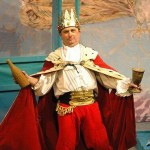Fancy dress on Purim
 Nobody is certain where the idea of fancy dress on Purim began.
Nobody is certain where the idea of fancy dress on Purim began.
There is a 15th century responsum from Rav Yehudah Mintz of Italy who says there is no prohibition on men wearing women’s attire on Purim because everyone knows it is for fun and has no sexual overtones. Rav Moshe Isserles quotes this responsum in his glosses to the Shulchan Aruch.
Some historians suggest that Purim fancy dress was an imitation of the Roman carnival which was held just before Lent. People took part in street parades wearing fancy dress and masks.
But this doesn’t necessarily explain our Purim custom. The Apter Rebbe, known as the Ohev Yisrael, acknowledges that the fancy dress minhag existed amongst Jews and was a form of mockery of the European norms that caused Jews such grief.
The Si’ach Yitzchak (Rav Yitzchak Weiss) thought that disguising oneself echoes the wicked Haman, who pretended to the king that he was genuinely concerned for the stability of the regime. The Talmud (Megillah 12a) points out that things often have hidden motives. However, many centuries elapsed between the time of the Talmud and the medieval adoption of the fancy dress custom.
There may be an explanation in a medieval Tosafot in Rosh HaShanah 3a which says that Haman’s ancestors the Amalekites tried to defeat Israel by changing their voices and their clothing. A piyyut (poem) for the Shabbat before Purim actually says Kesut velashon shinah – “he (Amalek) changed his voice and his clothing”.
How can we allow ourselves to mimic our enemies, the Amalekites and the wicked Haman? Simply because we see the funny side in our enemies being brought low despite all their pretensions.
(This article is based on an essay written by Rabbi Yair Hoffman in 2010)



